Healthcare Workplace Infection Prevention and Control Assignment
VerifiedAdded on 2020/01/07
|9
|2378
|1240
Homework Assignment
AI Summary
This assignment assesses the student's understanding of infection prevention and control in healthcare settings, based on the Australian Guidelines for the Prevention and Control of Infection in Healthcare. The assignment is divided into four tasks. Task 1 focuses on standard and transmission-based precautions, requiring the student to select a precaution, describe how to put it into practice, and summarize the application of transmission-based precautions. Task 2 presents a case study involving a clinical waste spill, prompting the student to describe their response, identify potential risks, and explain how to inform others of the risk. Task 3 delves into cleaning the healthcare environment, including PPE use, detergent/disinfectant application, and equipment sterilization. It also covers clinical waste management processes. Task 4 explores clean and contaminated zones, asking the student to define their purpose and what should be maintained or confined within them. The assignment aims to test the student's ability to apply their knowledge to real-world scenarios, emphasizing critical thinking and understanding of infection control principles.
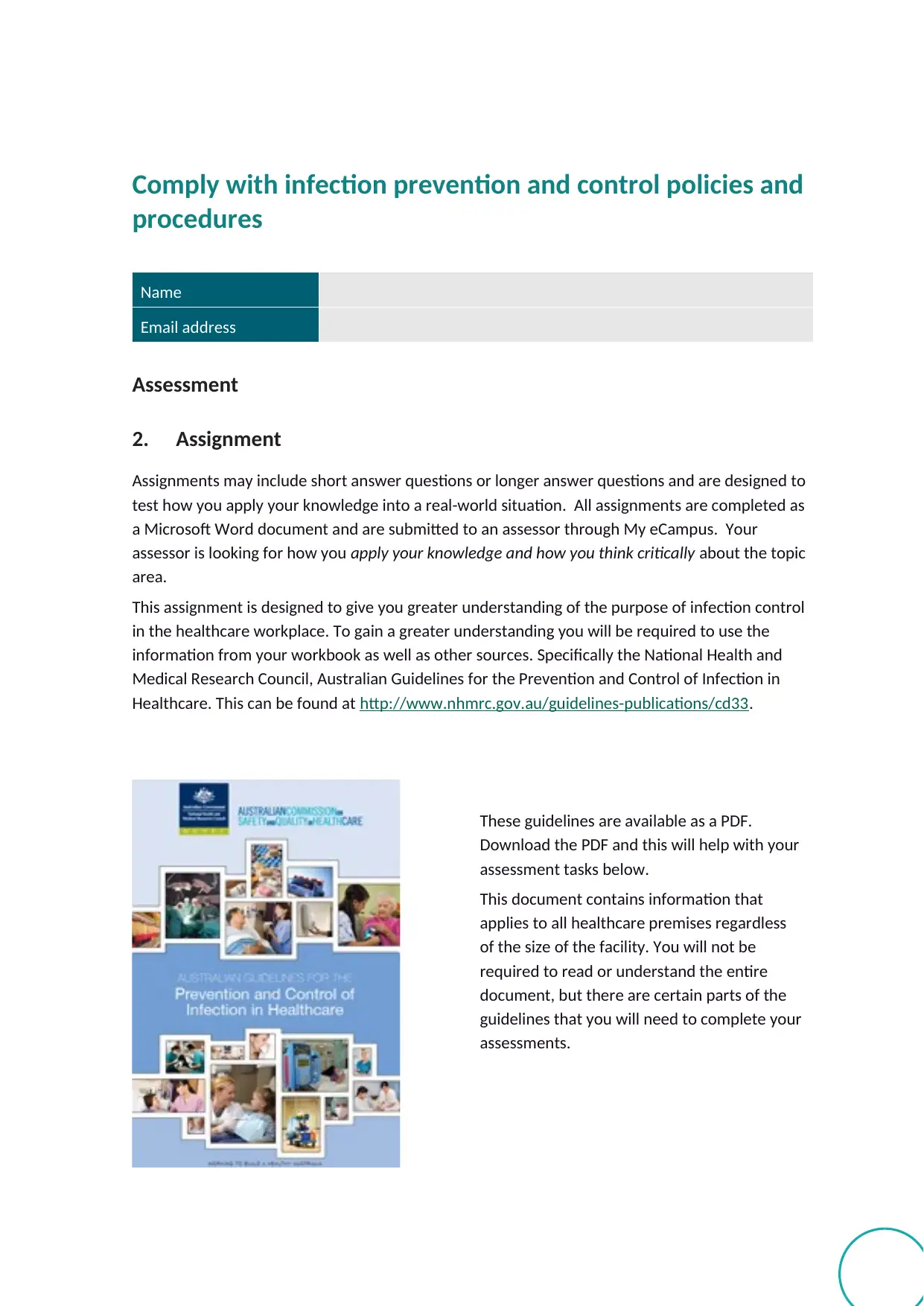
Comply with infection prevention and control policies and
procedures
Name
Email address
Assessment
2. Assignment
Assignments may include short answer questions or longer answer questions and are designed to
test how you apply your knowledge into a real-world situation. All assignments are completed as
a Microsoft Word document and are submitted to an assessor through My eCampus. Your
assessor is looking for how you apply your knowledge and how you think critically about the topic
area.
This assignment is designed to give you greater understanding of the purpose of infection control
in the healthcare workplace. To gain a greater understanding you will be required to use the
information from your workbook as well as other sources. Specifically the National Health and
Medical Research Council, Australian Guidelines for the Prevention and Control of Infection in
Healthcare. This can be found at http://www.nhmrc.gov.au/guidelines-publications/cd33.
These guidelines are available as a PDF.
Download the PDF and this will help with your
assessment tasks below.
This document contains information that
applies to all healthcare premises regardless
of the size of the facility. You will not be
required to read or understand the entire
document, but there are certain parts of the
guidelines that you will need to complete your
assessments.
procedures
Name
Email address
Assessment
2. Assignment
Assignments may include short answer questions or longer answer questions and are designed to
test how you apply your knowledge into a real-world situation. All assignments are completed as
a Microsoft Word document and are submitted to an assessor through My eCampus. Your
assessor is looking for how you apply your knowledge and how you think critically about the topic
area.
This assignment is designed to give you greater understanding of the purpose of infection control
in the healthcare workplace. To gain a greater understanding you will be required to use the
information from your workbook as well as other sources. Specifically the National Health and
Medical Research Council, Australian Guidelines for the Prevention and Control of Infection in
Healthcare. This can be found at http://www.nhmrc.gov.au/guidelines-publications/cd33.
These guidelines are available as a PDF.
Download the PDF and this will help with your
assessment tasks below.
This document contains information that
applies to all healthcare premises regardless
of the size of the facility. You will not be
required to read or understand the entire
document, but there are certain parts of the
guidelines that you will need to complete your
assessments.
Paraphrase This Document
Need a fresh take? Get an instant paraphrase of this document with our AI Paraphraser
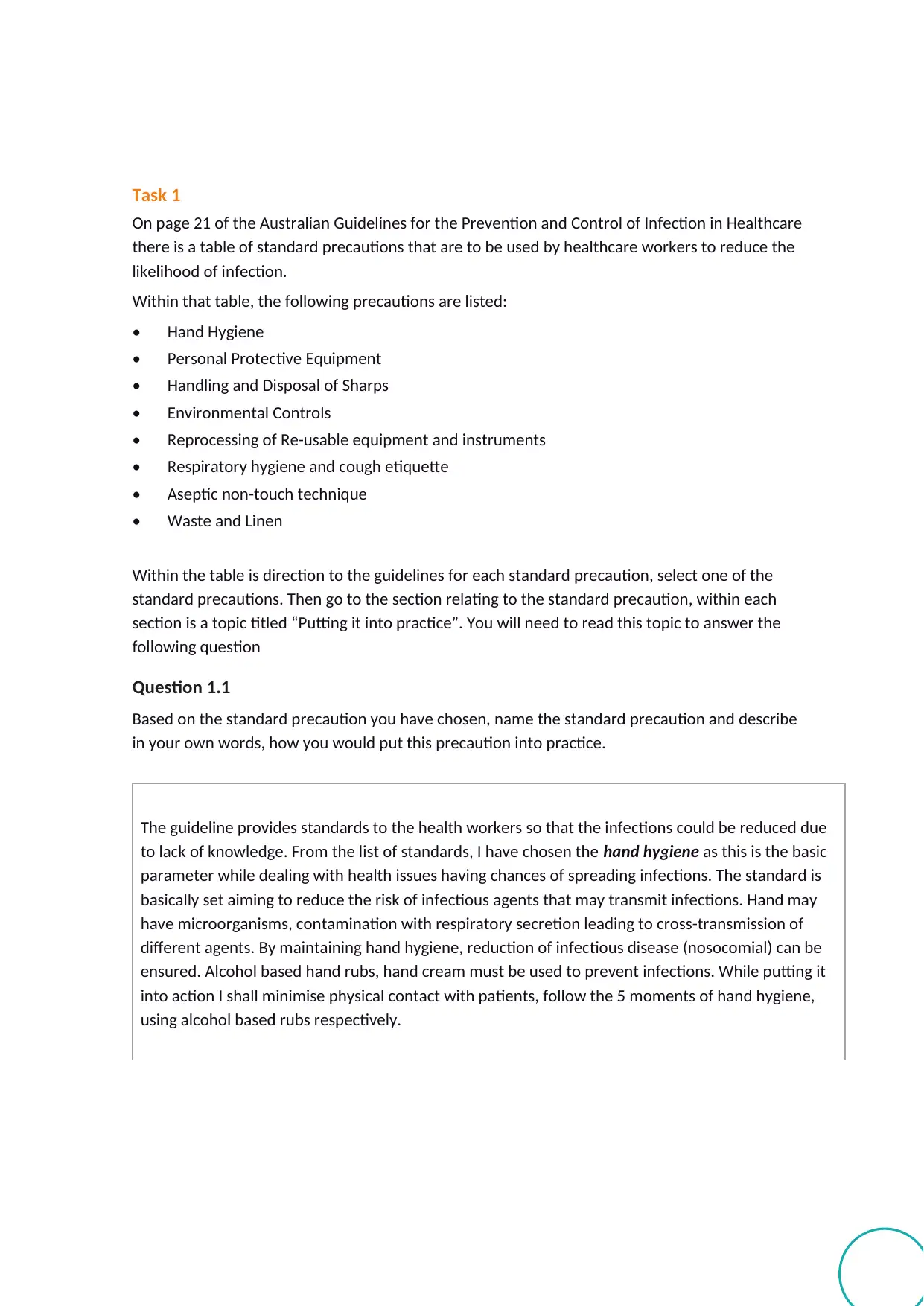
Task 1
On page 21 of the Australian Guidelines for the Prevention and Control of Infection in Healthcare
there is a table of standard precautions that are to be used by healthcare workers to reduce the
likelihood of infection.
Within that table, the following precautions are listed:
• Hand Hygiene
• Personal Protective Equipment
• Handling and Disposal of Sharps
• Environmental Controls
• Reprocessing of Re-usable equipment and instruments
• Respiratory hygiene and cough etiquette
• Aseptic non-touch technique
• Waste and Linen
Within the table is direction to the guidelines for each standard precaution, select one of the
standard precautions. Then go to the section relating to the standard precaution, within each
section is a topic titled “Putting it into practice”. You will need to read this topic to answer the
following question
Question 1.1
Based on the standard precaution you have chosen, name the standard precaution and describe
in your own words, how you would put this precaution into practice.
The guideline provides standards to the health workers so that the infections could be reduced due
to lack of knowledge. From the list of standards, I have chosen the hand hygiene as this is the basic
parameter while dealing with health issues having chances of spreading infections. The standard is
basically set aiming to reduce the risk of infectious agents that may transmit infections. Hand may
have microorganisms, contamination with respiratory secretion leading to cross-transmission of
different agents. By maintaining hand hygiene, reduction of infectious disease (nosocomial) can be
ensured. Alcohol based hand rubs, hand cream must be used to prevent infections. While putting it
into action I shall minimise physical contact with patients, follow the 5 moments of hand hygiene,
using alcohol based rubs respectively.
On page 21 of the Australian Guidelines for the Prevention and Control of Infection in Healthcare
there is a table of standard precautions that are to be used by healthcare workers to reduce the
likelihood of infection.
Within that table, the following precautions are listed:
• Hand Hygiene
• Personal Protective Equipment
• Handling and Disposal of Sharps
• Environmental Controls
• Reprocessing of Re-usable equipment and instruments
• Respiratory hygiene and cough etiquette
• Aseptic non-touch technique
• Waste and Linen
Within the table is direction to the guidelines for each standard precaution, select one of the
standard precautions. Then go to the section relating to the standard precaution, within each
section is a topic titled “Putting it into practice”. You will need to read this topic to answer the
following question
Question 1.1
Based on the standard precaution you have chosen, name the standard precaution and describe
in your own words, how you would put this precaution into practice.
The guideline provides standards to the health workers so that the infections could be reduced due
to lack of knowledge. From the list of standards, I have chosen the hand hygiene as this is the basic
parameter while dealing with health issues having chances of spreading infections. The standard is
basically set aiming to reduce the risk of infectious agents that may transmit infections. Hand may
have microorganisms, contamination with respiratory secretion leading to cross-transmission of
different agents. By maintaining hand hygiene, reduction of infectious disease (nosocomial) can be
ensured. Alcohol based hand rubs, hand cream must be used to prevent infections. While putting it
into action I shall minimise physical contact with patients, follow the 5 moments of hand hygiene,
using alcohol based rubs respectively.
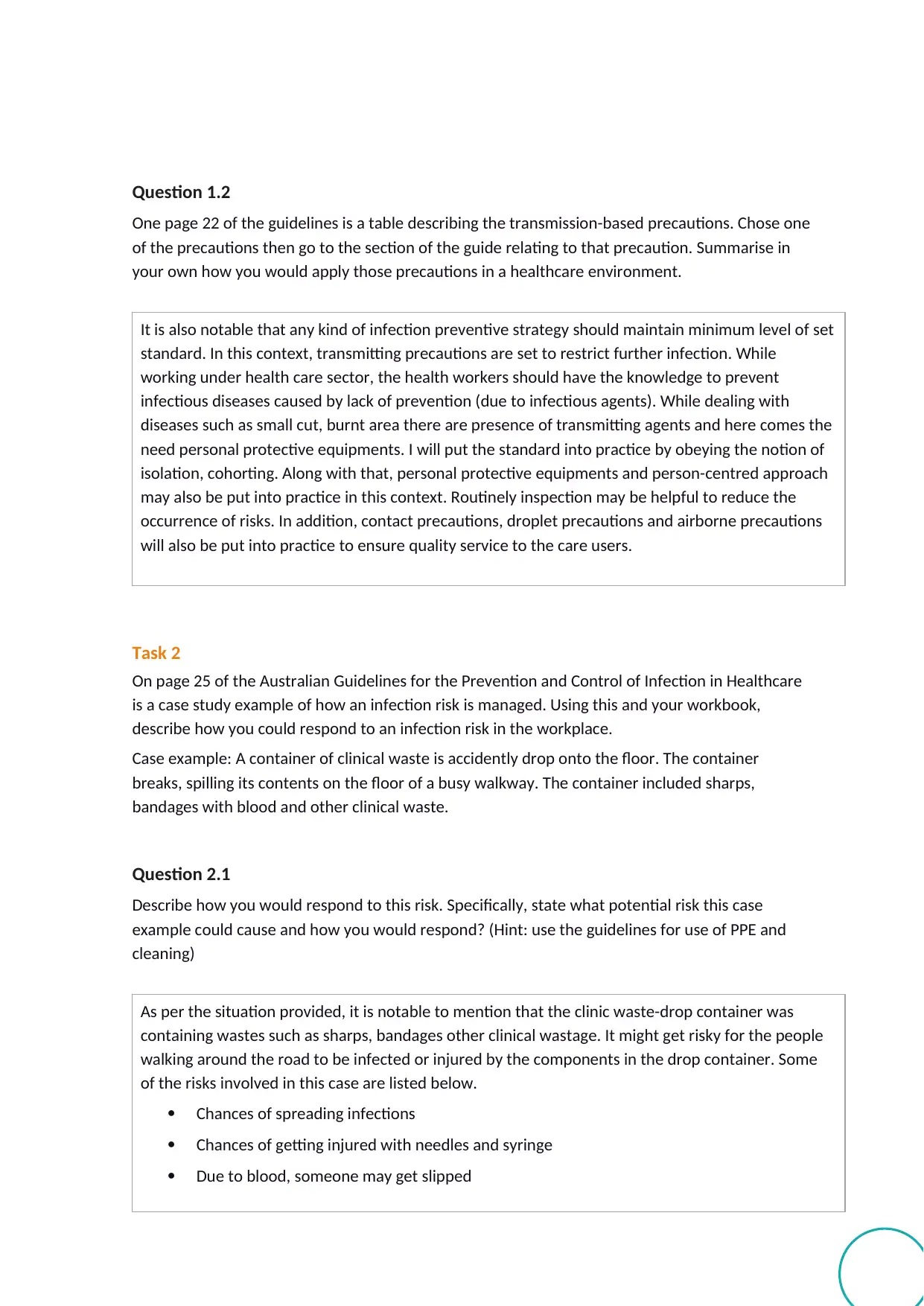
Question 1.2
One page 22 of the guidelines is a table describing the transmission-based precautions. Chose one
of the precautions then go to the section of the guide relating to that precaution. Summarise in
your own how you would apply those precautions in a healthcare environment.
It is also notable that any kind of infection preventive strategy should maintain minimum level of set
standard. In this context, transmitting precautions are set to restrict further infection. While
working under health care sector, the health workers should have the knowledge to prevent
infectious diseases caused by lack of prevention (due to infectious agents). While dealing with
diseases such as small cut, burnt area there are presence of transmitting agents and here comes the
need personal protective equipments. I will put the standard into practice by obeying the notion of
isolation, cohorting. Along with that, personal protective equipments and person-centred approach
may also be put into practice in this context. Routinely inspection may be helpful to reduce the
occurrence of risks. In addition, contact precautions, droplet precautions and airborne precautions
will also be put into practice to ensure quality service to the care users.
Task 2
On page 25 of the Australian Guidelines for the Prevention and Control of Infection in Healthcare
is a case study example of how an infection risk is managed. Using this and your workbook,
describe how you could respond to an infection risk in the workplace.
Case example: A container of clinical waste is accidently drop onto the floor. The container
breaks, spilling its contents on the floor of a busy walkway. The container included sharps,
bandages with blood and other clinical waste.
Question 2.1
Describe how you would respond to this risk. Specifically, state what potential risk this case
example could cause and how you would respond? (Hint: use the guidelines for use of PPE and
cleaning)
As per the situation provided, it is notable to mention that the clinic waste-drop container was
containing wastes such as sharps, bandages other clinical wastage. It might get risky for the people
walking around the road to be infected or injured by the components in the drop container. Some
of the risks involved in this case are listed below.
Chances of spreading infections
Chances of getting injured with needles and syringe
Due to blood, someone may get slipped
One page 22 of the guidelines is a table describing the transmission-based precautions. Chose one
of the precautions then go to the section of the guide relating to that precaution. Summarise in
your own how you would apply those precautions in a healthcare environment.
It is also notable that any kind of infection preventive strategy should maintain minimum level of set
standard. In this context, transmitting precautions are set to restrict further infection. While
working under health care sector, the health workers should have the knowledge to prevent
infectious diseases caused by lack of prevention (due to infectious agents). While dealing with
diseases such as small cut, burnt area there are presence of transmitting agents and here comes the
need personal protective equipments. I will put the standard into practice by obeying the notion of
isolation, cohorting. Along with that, personal protective equipments and person-centred approach
may also be put into practice in this context. Routinely inspection may be helpful to reduce the
occurrence of risks. In addition, contact precautions, droplet precautions and airborne precautions
will also be put into practice to ensure quality service to the care users.
Task 2
On page 25 of the Australian Guidelines for the Prevention and Control of Infection in Healthcare
is a case study example of how an infection risk is managed. Using this and your workbook,
describe how you could respond to an infection risk in the workplace.
Case example: A container of clinical waste is accidently drop onto the floor. The container
breaks, spilling its contents on the floor of a busy walkway. The container included sharps,
bandages with blood and other clinical waste.
Question 2.1
Describe how you would respond to this risk. Specifically, state what potential risk this case
example could cause and how you would respond? (Hint: use the guidelines for use of PPE and
cleaning)
As per the situation provided, it is notable to mention that the clinic waste-drop container was
containing wastes such as sharps, bandages other clinical wastage. It might get risky for the people
walking around the road to be infected or injured by the components in the drop container. Some
of the risks involved in this case are listed below.
Chances of spreading infections
Chances of getting injured with needles and syringe
Due to blood, someone may get slipped
⊘ This is a preview!⊘
Do you want full access?
Subscribe today to unlock all pages.

Trusted by 1+ million students worldwide
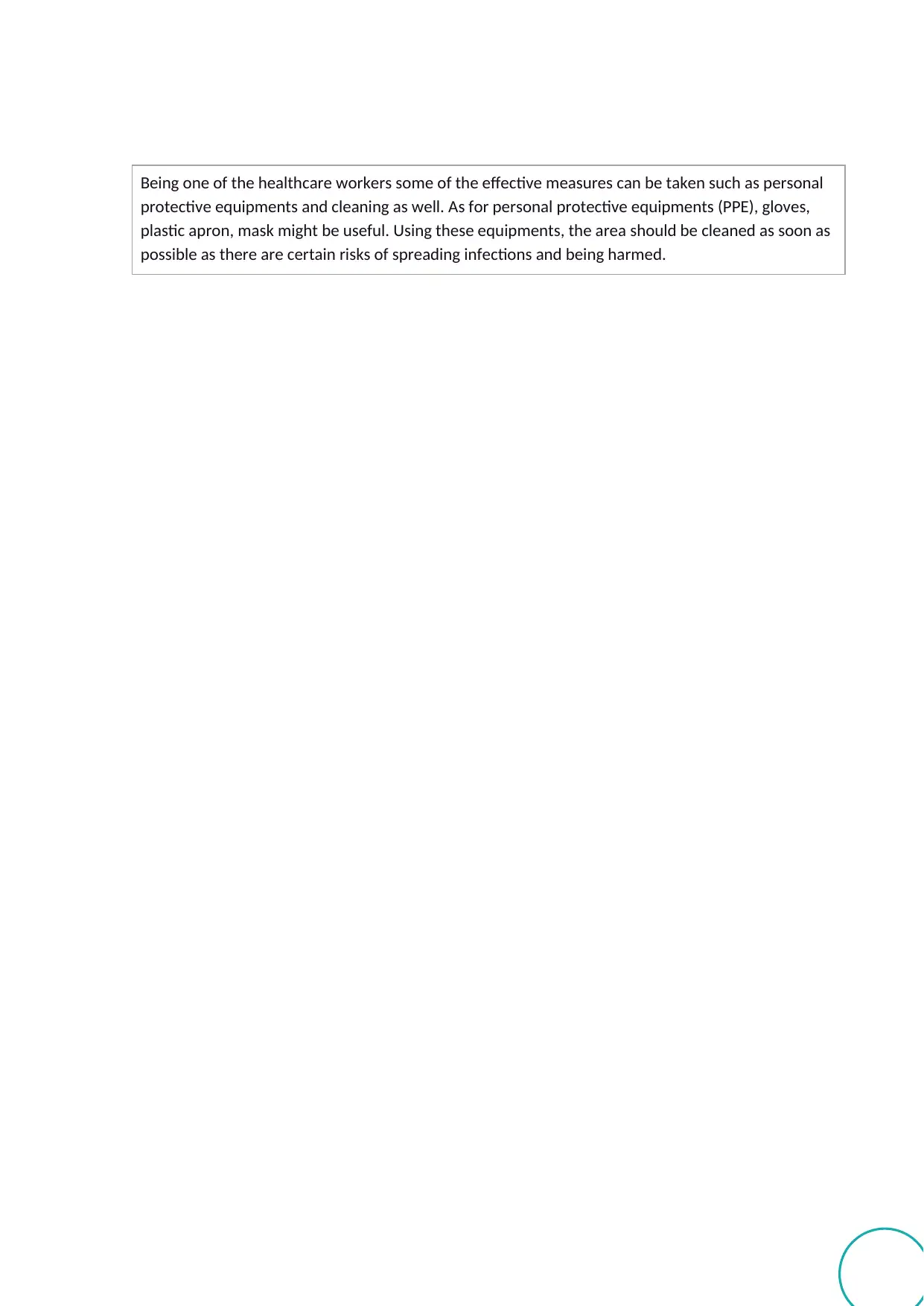
Being one of the healthcare workers some of the effective measures can be taken such as personal
protective equipments and cleaning as well. As for personal protective equipments (PPE), gloves,
plastic apron, mask might be useful. Using these equipments, the area should be cleaned as soon as
possible as there are certain risks of spreading infections and being harmed.
protective equipments and cleaning as well. As for personal protective equipments (PPE), gloves,
plastic apron, mask might be useful. Using these equipments, the area should be cleaned as soon as
possible as there are certain risks of spreading infections and being harmed.
Paraphrase This Document
Need a fresh take? Get an instant paraphrase of this document with our AI Paraphraser
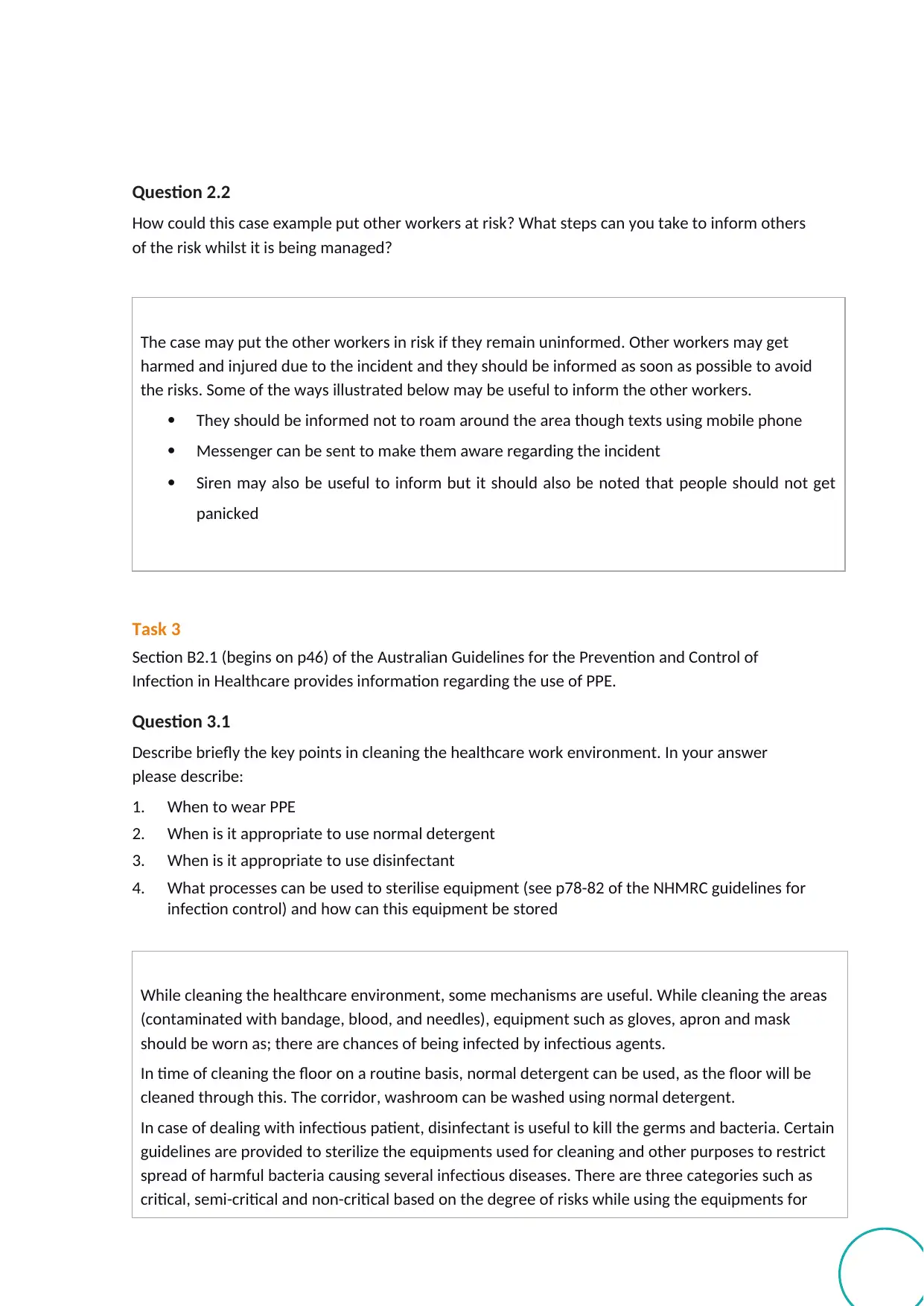
Question 2.2
How could this case example put other workers at risk? What steps can you take to inform others
of the risk whilst it is being managed?
The case may put the other workers in risk if they remain uninformed. Other workers may get
harmed and injured due to the incident and they should be informed as soon as possible to avoid
the risks. Some of the ways illustrated below may be useful to inform the other workers.
They should be informed not to roam around the area though texts using mobile phone
Messenger can be sent to make them aware regarding the incident
Siren may also be useful to inform but it should also be noted that people should not get
panicked
Task 3
Section B2.1 (begins on p46) of the Australian Guidelines for the Prevention and Control of
Infection in Healthcare provides information regarding the use of PPE.
Question 3.1
Describe briefly the key points in cleaning the healthcare work environment. In your answer
please describe:
1. When to wear PPE
2. When is it appropriate to use normal detergent
3. When is it appropriate to use disinfectant
4. What processes can be used to sterilise equipment (see p78-82 of the NHMRC guidelines for
infection control) and how can this equipment be stored
While cleaning the healthcare environment, some mechanisms are useful. While cleaning the areas
(contaminated with bandage, blood, and needles), equipment such as gloves, apron and mask
should be worn as; there are chances of being infected by infectious agents.
In time of cleaning the floor on a routine basis, normal detergent can be used, as the floor will be
cleaned through this. The corridor, washroom can be washed using normal detergent.
In case of dealing with infectious patient, disinfectant is useful to kill the germs and bacteria. Certain
guidelines are provided to sterilize the equipments used for cleaning and other purposes to restrict
spread of harmful bacteria causing several infectious diseases. There are three categories such as
critical, semi-critical and non-critical based on the degree of risks while using the equipments for
How could this case example put other workers at risk? What steps can you take to inform others
of the risk whilst it is being managed?
The case may put the other workers in risk if they remain uninformed. Other workers may get
harmed and injured due to the incident and they should be informed as soon as possible to avoid
the risks. Some of the ways illustrated below may be useful to inform the other workers.
They should be informed not to roam around the area though texts using mobile phone
Messenger can be sent to make them aware regarding the incident
Siren may also be useful to inform but it should also be noted that people should not get
panicked
Task 3
Section B2.1 (begins on p46) of the Australian Guidelines for the Prevention and Control of
Infection in Healthcare provides information regarding the use of PPE.
Question 3.1
Describe briefly the key points in cleaning the healthcare work environment. In your answer
please describe:
1. When to wear PPE
2. When is it appropriate to use normal detergent
3. When is it appropriate to use disinfectant
4. What processes can be used to sterilise equipment (see p78-82 of the NHMRC guidelines for
infection control) and how can this equipment be stored
While cleaning the healthcare environment, some mechanisms are useful. While cleaning the areas
(contaminated with bandage, blood, and needles), equipment such as gloves, apron and mask
should be worn as; there are chances of being infected by infectious agents.
In time of cleaning the floor on a routine basis, normal detergent can be used, as the floor will be
cleaned through this. The corridor, washroom can be washed using normal detergent.
In case of dealing with infectious patient, disinfectant is useful to kill the germs and bacteria. Certain
guidelines are provided to sterilize the equipments used for cleaning and other purposes to restrict
spread of harmful bacteria causing several infectious diseases. There are three categories such as
critical, semi-critical and non-critical based on the degree of risks while using the equipments for
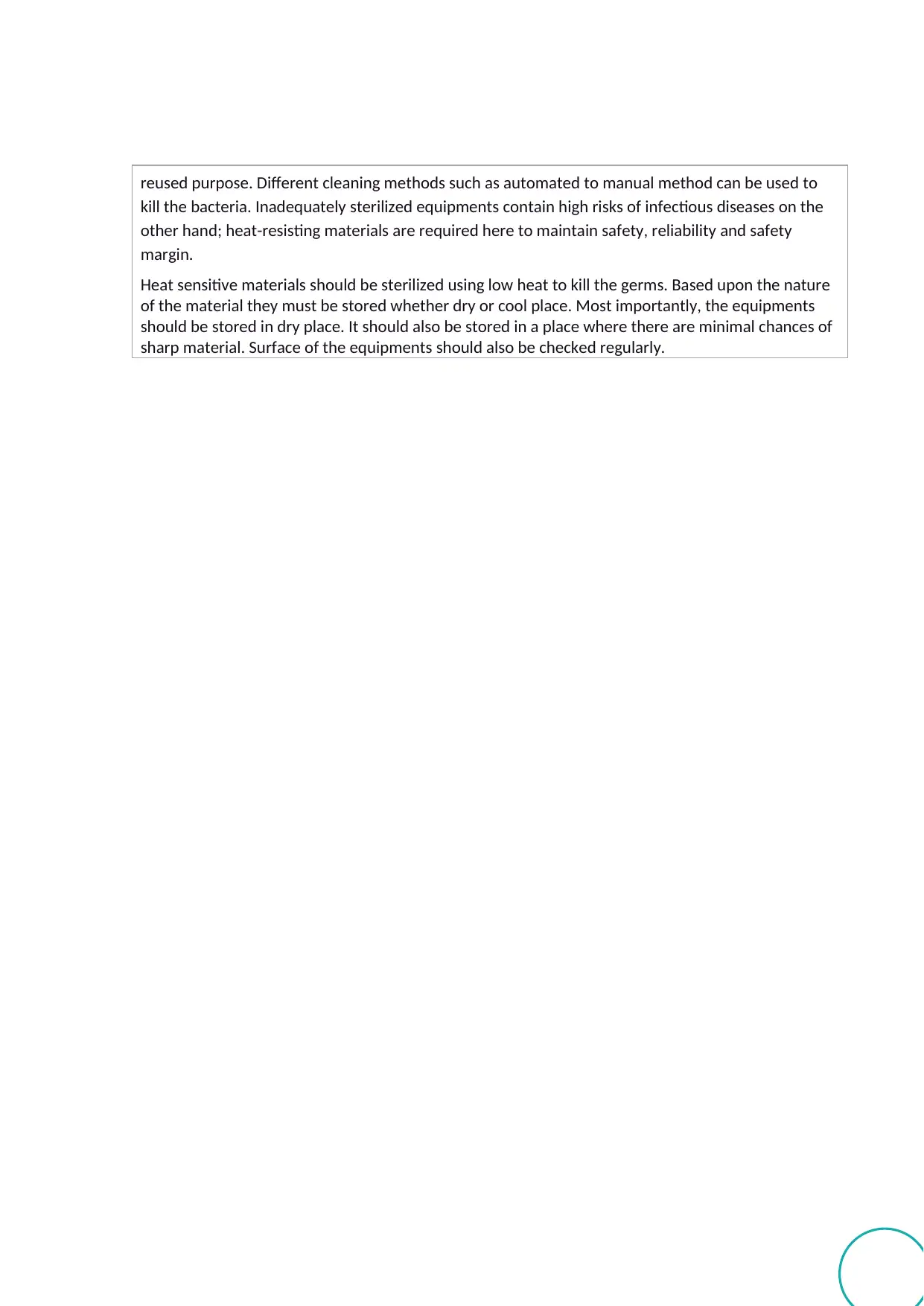
reused purpose. Different cleaning methods such as automated to manual method can be used to
kill the bacteria. Inadequately sterilized equipments contain high risks of infectious diseases on the
other hand; heat-resisting materials are required here to maintain safety, reliability and safety
margin.
Heat sensitive materials should be sterilized using low heat to kill the germs. Based upon the nature
of the material they must be stored whether dry or cool place. Most importantly, the equipments
should be stored in dry place. It should also be stored in a place where there are minimal chances of
sharp material. Surface of the equipments should also be checked regularly.
kill the bacteria. Inadequately sterilized equipments contain high risks of infectious diseases on the
other hand; heat-resisting materials are required here to maintain safety, reliability and safety
margin.
Heat sensitive materials should be sterilized using low heat to kill the germs. Based upon the nature
of the material they must be stored whether dry or cool place. Most importantly, the equipments
should be stored in dry place. It should also be stored in a place where there are minimal chances of
sharp material. Surface of the equipments should also be checked regularly.
⊘ This is a preview!⊘
Do you want full access?
Subscribe today to unlock all pages.

Trusted by 1+ million students worldwide
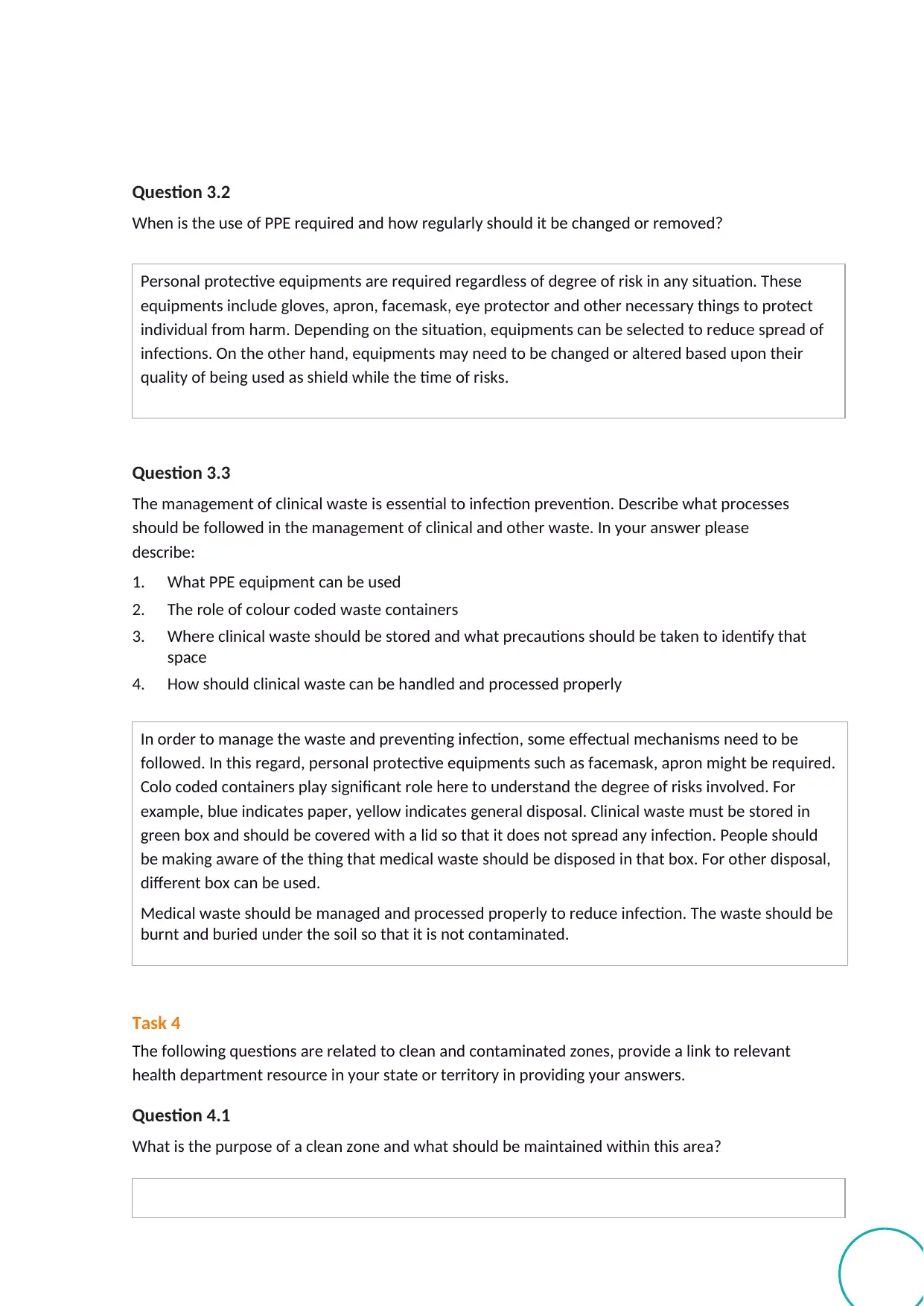
Question 3.2
When is the use of PPE required and how regularly should it be changed or removed?
Personal protective equipments are required regardless of degree of risk in any situation. These
equipments include gloves, apron, facemask, eye protector and other necessary things to protect
individual from harm. Depending on the situation, equipments can be selected to reduce spread of
infections. On the other hand, equipments may need to be changed or altered based upon their
quality of being used as shield while the time of risks.
Question 3.3
The management of clinical waste is essential to infection prevention. Describe what processes
should be followed in the management of clinical and other waste. In your answer please
describe:
1. What PPE equipment can be used
2. The role of colour coded waste containers
3. Where clinical waste should be stored and what precautions should be taken to identify that
space
4. How should clinical waste can be handled and processed properly
In order to manage the waste and preventing infection, some effectual mechanisms need to be
followed. In this regard, personal protective equipments such as facemask, apron might be required.
Colo coded containers play significant role here to understand the degree of risks involved. For
example, blue indicates paper, yellow indicates general disposal. Clinical waste must be stored in
green box and should be covered with a lid so that it does not spread any infection. People should
be making aware of the thing that medical waste should be disposed in that box. For other disposal,
different box can be used.
Medical waste should be managed and processed properly to reduce infection. The waste should be
burnt and buried under the soil so that it is not contaminated.
Task 4
The following questions are related to clean and contaminated zones, provide a link to relevant
health department resource in your state or territory in providing your answers.
Question 4.1
What is the purpose of a clean zone and what should be maintained within this area?
When is the use of PPE required and how regularly should it be changed or removed?
Personal protective equipments are required regardless of degree of risk in any situation. These
equipments include gloves, apron, facemask, eye protector and other necessary things to protect
individual from harm. Depending on the situation, equipments can be selected to reduce spread of
infections. On the other hand, equipments may need to be changed or altered based upon their
quality of being used as shield while the time of risks.
Question 3.3
The management of clinical waste is essential to infection prevention. Describe what processes
should be followed in the management of clinical and other waste. In your answer please
describe:
1. What PPE equipment can be used
2. The role of colour coded waste containers
3. Where clinical waste should be stored and what precautions should be taken to identify that
space
4. How should clinical waste can be handled and processed properly
In order to manage the waste and preventing infection, some effectual mechanisms need to be
followed. In this regard, personal protective equipments such as facemask, apron might be required.
Colo coded containers play significant role here to understand the degree of risks involved. For
example, blue indicates paper, yellow indicates general disposal. Clinical waste must be stored in
green box and should be covered with a lid so that it does not spread any infection. People should
be making aware of the thing that medical waste should be disposed in that box. For other disposal,
different box can be used.
Medical waste should be managed and processed properly to reduce infection. The waste should be
burnt and buried under the soil so that it is not contaminated.
Task 4
The following questions are related to clean and contaminated zones, provide a link to relevant
health department resource in your state or territory in providing your answers.
Question 4.1
What is the purpose of a clean zone and what should be maintained within this area?
Paraphrase This Document
Need a fresh take? Get an instant paraphrase of this document with our AI Paraphraser

The Clean Zone refers to the area where the disinfected and non-contaminated items are
persevered to comply with the health and safety policy of the healthcare organisations. Therefore
the zone possesses the items to maintain the hygiene in health care services and practices. Some of
the examples of such zone involve sterile instruments, place of keeping clean linen, kitchen area of
the medical institutes and the store area of the healthcare sector. Therefore, the clean zone is the
factor preventing the health of the patients from infectious elements and processes. In
continuation, the zone would therefore, be termed as the key area playing supporting role of the
main treatment process. Therefore, there are some restrictions in accessing the region to maintain
the principles of this zone. The healthcare staffs are liable to remove the contaminated elements
like used gloves, aprons an d other PPE to maintain the hand hygiene in this place.
On the other hand, such zone needs proper supervision and strict compliance of the hygiene rules
and practices. Key purpose of the clean zone is to provide a highly hygienic service in the healthcare
services and other treatment procedures with sound protection from the infectious elements.
Therefore, the elements for cleaning and preventing the non-contaminated need also the use of the
cleaning agents and disinfected products to ensure the non-contamination and maintenance of the
healthcare elements for proper treatment and healthcare service provision.
persevered to comply with the health and safety policy of the healthcare organisations. Therefore
the zone possesses the items to maintain the hygiene in health care services and practices. Some of
the examples of such zone involve sterile instruments, place of keeping clean linen, kitchen area of
the medical institutes and the store area of the healthcare sector. Therefore, the clean zone is the
factor preventing the health of the patients from infectious elements and processes. In
continuation, the zone would therefore, be termed as the key area playing supporting role of the
main treatment process. Therefore, there are some restrictions in accessing the region to maintain
the principles of this zone. The healthcare staffs are liable to remove the contaminated elements
like used gloves, aprons an d other PPE to maintain the hand hygiene in this place.
On the other hand, such zone needs proper supervision and strict compliance of the hygiene rules
and practices. Key purpose of the clean zone is to provide a highly hygienic service in the healthcare
services and other treatment procedures with sound protection from the infectious elements.
Therefore, the elements for cleaning and preventing the non-contaminated need also the use of the
cleaning agents and disinfected products to ensure the non-contamination and maintenance of the
healthcare elements for proper treatment and healthcare service provision.
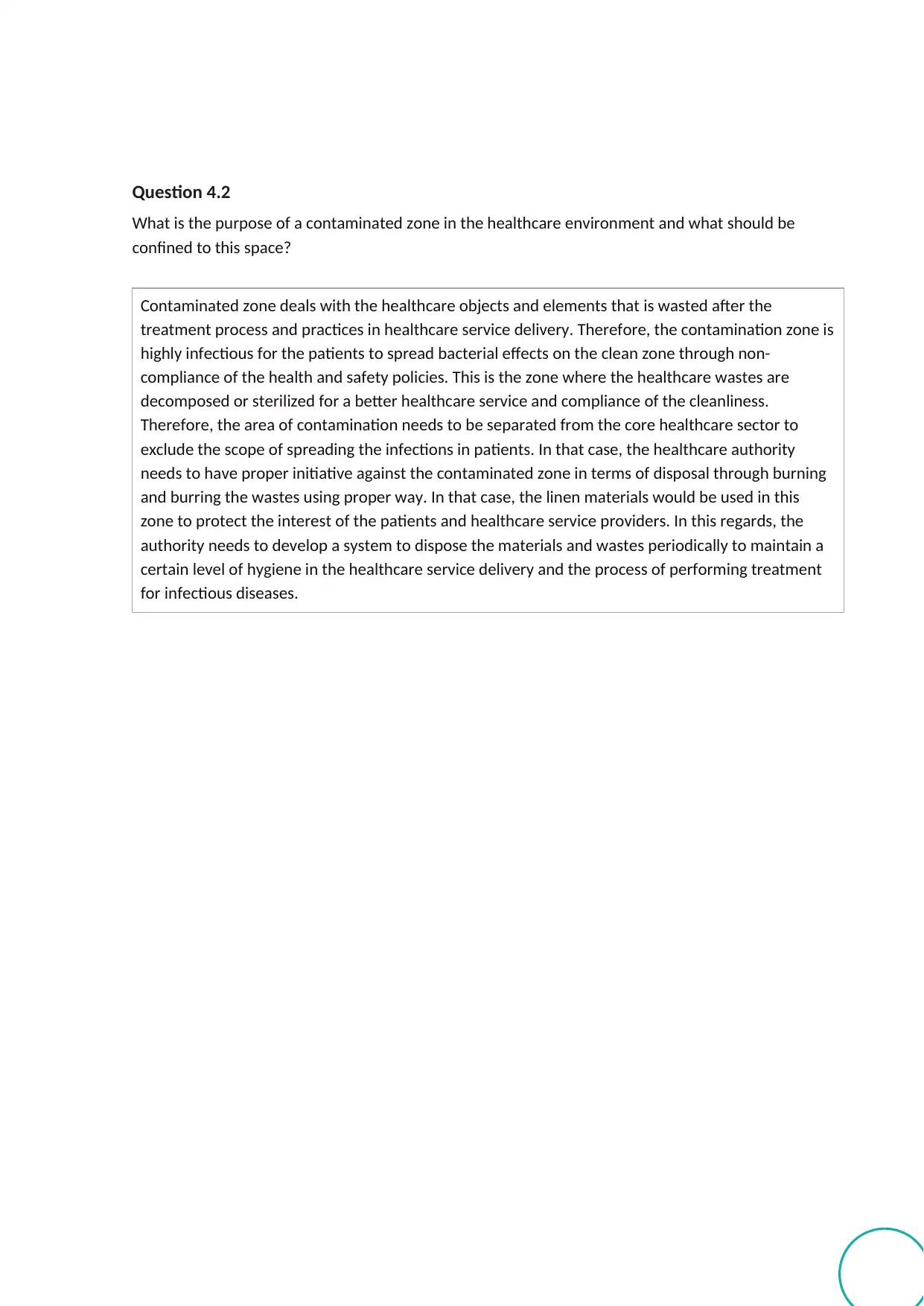
Question 4.2
What is the purpose of a contaminated zone in the healthcare environment and what should be
confined to this space?
Contaminated zone deals with the healthcare objects and elements that is wasted after the
treatment process and practices in healthcare service delivery. Therefore, the contamination zone is
highly infectious for the patients to spread bacterial effects on the clean zone through non-
compliance of the health and safety policies. This is the zone where the healthcare wastes are
decomposed or sterilized for a better healthcare service and compliance of the cleanliness.
Therefore, the area of contamination needs to be separated from the core healthcare sector to
exclude the scope of spreading the infections in patients. In that case, the healthcare authority
needs to have proper initiative against the contaminated zone in terms of disposal through burning
and burring the wastes using proper way. In that case, the linen materials would be used in this
zone to protect the interest of the patients and healthcare service providers. In this regards, the
authority needs to develop a system to dispose the materials and wastes periodically to maintain a
certain level of hygiene in the healthcare service delivery and the process of performing treatment
for infectious diseases.
What is the purpose of a contaminated zone in the healthcare environment and what should be
confined to this space?
Contaminated zone deals with the healthcare objects and elements that is wasted after the
treatment process and practices in healthcare service delivery. Therefore, the contamination zone is
highly infectious for the patients to spread bacterial effects on the clean zone through non-
compliance of the health and safety policies. This is the zone where the healthcare wastes are
decomposed or sterilized for a better healthcare service and compliance of the cleanliness.
Therefore, the area of contamination needs to be separated from the core healthcare sector to
exclude the scope of spreading the infections in patients. In that case, the healthcare authority
needs to have proper initiative against the contaminated zone in terms of disposal through burning
and burring the wastes using proper way. In that case, the linen materials would be used in this
zone to protect the interest of the patients and healthcare service providers. In this regards, the
authority needs to develop a system to dispose the materials and wastes periodically to maintain a
certain level of hygiene in the healthcare service delivery and the process of performing treatment
for infectious diseases.
⊘ This is a preview!⊘
Do you want full access?
Subscribe today to unlock all pages.

Trusted by 1+ million students worldwide
1 out of 9
Related Documents
Your All-in-One AI-Powered Toolkit for Academic Success.
+13062052269
info@desklib.com
Available 24*7 on WhatsApp / Email
![[object Object]](/_next/static/media/star-bottom.7253800d.svg)
Unlock your academic potential
Copyright © 2020–2025 A2Z Services. All Rights Reserved. Developed and managed by ZUCOL.





